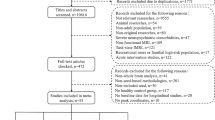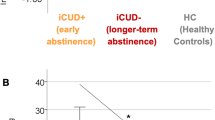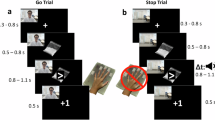Abstract
Altered impulse control is associated with substance use disorders, including cocaine dependence. We sought to identify the neural correlates of impulse control in abstinent male patients with cocaine dependence (PCD). Functional magnetic resonance imaging (fMRI) was conducted during a stop signal task that allowed trial-by-trial evaluation of response inhibition. Fifteen male PCD and 15 healthy control (HC) subjects, matched in age and years of education, were compared. Stop signal reaction time (SSRT) was derived on the basis of a horse race model. By comparing PCD and HC co-varied for stop success rate, task-related frustration rating, and post-error slowing, we isolated the neural substrates of response inhibition, independent of attentional monitoring (of the stop signal) and post-response processes including affective responses and error monitoring. Using region of interest analysis, we found no differences between HC and PCD who were matched in stop signal performance in the pre-supplementary motor area (pre-SMA) previously shown to be associated with SSRT. However, compared with HC, PCD demonstrated less activation of the rostral anterior cingulate cortex (rACC), an area thought to be involved in the control of stop signal inhibition. The magnitude of rACC activation also correlated negatively with the total score and the impulse control subscore of the Difficulty in Emotion Regulation Scale in PCD. The current study thus identified the neural correlates of altered impulse control in PCD independent of other cognitive processes that may influence stop signal performance. Relative hypoactivation of the rACC during response inhibition may represent a useful neural marker of difficulties in impulse control in abstinent cocaine-dependent men who are at risk of relapse.
Similar content being viewed by others
Log in or create a free account to read this content
Gain free access to this article, as well as selected content from this journal and more on nature.com
or
References
Adinoff B, Devous Sr MD, Cooper DB, Best SE, Chandler P, Harris T et al (2003). Resting regional cerebral blood flow and gambling task performance in cocaine-dependent subjects and healthy comparison subjects. Am J Psychiatry 160: 1892–1894.
Adinoff B, Williams MJ, Best SE, Harris TS, Chandler P, Devous Sr MD (2006). Sex differences in medial and lateral orbitofrontal cortex hypoperfusion in cocaine-dependent men and women. Gend Med 3: 206–222.
Aron JL, Paulus MP (2007). Location, location: using functional magnetic resonance imaging to pinpoint brain differences relevant to stimulant use. Addiction 102 (Suppl 1): 33–43.
Ashburner J, Friston KJ (1999). Nonlinear spatial normalization using basis functions. Hum Brain Mapp 7: 254–266.
Bolla KI, Eldreth DA, London ED, Kiehl KA, Mouratidis M, Contoreggi C et al (2003). Orbitofrontal cortex dysfunction in abstinent cocaine abusers performing a decision-making task. Neuroimage 19: 1085–1094.
Brady KT, Randall CL (1999). Gender differences in substance use disorders. Psychiatr Clin North Am 22: 241–252.
Brett M, Anton J-L, Valabregue R, Poline J-P (2002). Region of interest analysis using an SPM toolbox. Abstract presented at the 8th International Conference on Functional Mapping of the Human Brain, June 2–6, Sendai, Japan.
Brown MR, Goltz HC, Vilis T, Ford KA, Everling S (2006). Inhibition and generation of saccades: rapid event-related fMRI of prosaccades, antisaccades, and nogo trials. Neuroimage 33: 644–659.
Bush G, Luu P, Posner MI (2000). Cognitive and emotional influences in anterior cingulate cortex. Trend Cognit Sci 4: 215–222.
Dawe S, Loxton NJ (2004). The role of impulsivity in the development of substance use and eating disorders. Neurosci Biobehav Rev 28: 343–351.
Dougherty DM, Mathias CW, Marsh DM, Moeller FG, Swann AC (2004). Suicidal behaviors and drug abuse: impulsivity and its assessment. Drug Alcohol Depend 76: S93–S105.
Ernst M, Paulus MP (2005). Neurobiology of decision making: a selective review from a neurocognitive and clinical perspective. Biol Psychiatry 58: 597–604.
Everitt BJ, Robbins TW (2005). Neural systems of reinforcement for drug addiction: from actions to habits to compulsion. Nat Rev Neurosci 8: 1481–1489.
First MB, Spitzer RL, Williams JBW, Gibbon M (1995). Structured Clinical Interview for DSM-IV (SCID). American Psychiatric Association: Washington DC.
Fox HC, Axelrod SR, Paliwal P, Sleeper J, Sinha R (2007). Difficulties in emotion regulation and impulse control during cocaine abstinence. Drug Alcoh Depend 89: 298–301.
Friston KJ, Ashburner J, Frith CD, Polone J-B, Heather JD, Frackowiak RSJ (1995a). Spatial registration and normalization of images. Hum Brain Mapp 2: 165–189.
Friston KJ, Holmes AP, Worsley KJ, Poline J-B, Frith CD, Frackowiak RSJ (1995b). Statistical parametric maps in functional imaging: a general linear approach. Hum Brain Mapp 2: 189–210.
Genovese CR, Lazar NA, Nichols T (2002). Thresholding of statistical maps in functional neuroimaging using the false discovery rate. Neuroimage 15: 870–878.
Goldstein JM, Jerram M, Poldrack R, Anagnoson R, Breiter HC, Makris N et al (2005). Sex differences in prefrontal cortical brain activity during fMRI of auditory verbal working memory. Neuropsychology 19: 509–519.
Goldstein RZ, Volkow ND (2002). Drug addiction and its underlying neurobiological basis: neuroimaging evidence for the involvement of the frontal cortex. Am J Psychiatry 159: 1642–1652.
Gratz KL, Roemer L (2004). Multidimensional assessment of emotion regulation and dsyregulation: development, factor structure, and initial validation of the difficulties in emotion regulation scale. J Psychopathol Behav Assess 26: 41–54.
Hajcak G, McDonald N, Simons RF (2003). To err is autonomic: error-related brain potentials, ANS activity, and post-error compensatory behavior. Psychophysiol 40: 895–903.
Hayaki J, Stein MD, Lassor JA, Herman DS, Anderson BJ (2005). Adversity among drug users: relationship to impulsivity. Drug Alcohol Depend 78: 65–71.
Hester R, Garavan H (2004). Executive dysfunction in cocaine addiction: evidence for discordant frontal, cingulate, and cerebellar activity. J Neurosci 24: 11017–11022.
Jovanovski D, Erb S, Zakzanis KK (2005). Neurocognitive deficits in cocaine users: a quantitative review of the evidence. J Clin Exp Neuropsychol 27: 189–204.
Kaufman JN, Ross TJ, Stein EA, Garavan H (2003). Cingulate hypoactivity in cocaine users during a GO-NOGO task as revealed by event-related functional magnetic resonance imaging. J Neurosci 23: 7839–7843.
Kim SJ, Lyoo IK, Hwang J, Sung YH, Lee HY, Lee DS et al (2005). Frontal glucose hypometabolism in abstinent methamphetamine users. Neuropsychopharmacol 30: 1383–1391.
Konishi S, Chikazoe J, Jimura K, Asari T, Miyashita Y (2005). Neural mechanism in anterior prefrontal cortex for inhibition of prolonged set interference. Proc Natl Acad Sci USA 102: 12584–12588.
Levitt H (1970). Transformed up-down methods in psychoacoustics. J Acoust Soc Am 49: 467–477.
Li C-SR, Huang C, Constable RT, Sinha R (2006a). Imaging response inhibition in a stop signal task—neural correlates independent of signal monitoring and post-response processing. J Neurosci 26: 186–192.
Li C-SR, Huang C, Constable RT, Sinha R (2006b). Gender differences in the neural correlates of response inhibition in a stop signal task. Neuroimage 32: 1918–1929.
Li C-SR, Kemp K, Milivojevic V, Sinha R (2005a). Neuroimaging study of sex differences in the neuropathology of cocaine abuse. Gend Med 2: 174–182.
Li C-SR, Kosten TR, Sinha R (2005b). Sex differences in brain activation during stress imagery in abstinent cocaine users: a functional magnetic resonance imaging study. Biol Psychiatry 57: 487–494.
Li C-SR, Krystal JH, Mathalon DH (2005c). Fore-period effect and stop signal processing time. Exp Brain Res 167: 305–309.
Li C-SR, Milivojevic V, Kemp KA, Hong K, Sinha R (2006c). Performance monitoring and stop signal inhibition in abstinent patients with cocaine dependence. Drug Alcoh Depend 85: 205–212.
Lie CH, Specht K, Marshall JC, Fink GR (2006). Using fMRI to decompose the neural processes underlying the Wisconsin Card Sorting Test. Neuroimage 30: 1038–1049.
Logan GD (1994). Inhibitory processes in attention, memory and language. In: Dagenbach D, Carr TH (eds). On the Ability to Inhibit Thought and Action: A User's Guide to the Stop Signal Paradigm. Academic Press: San Diego. pp 189–239.
Meyer-Lindenberg A, Buckholtz JW, Kolachana B, R Hariri A, Pezawas L, Blasi G et al (2006). Neural mechanisms of genetic risk for impulsivity and violence in humans. Proc Natl Acad Sci USA 103: 6269–6274.
Moeller FG, Barratt ES, Dougherty DM, Schmitz JM, Swann AC (2001). Psychiatric aspects of impulsivity. Am J Psychiatry 158: 1783–1793.
Rabbit PMA (1966). Errors and error correction in choice-response tasks. J Exp Psychol 71: 264–272.
Ridderinkhof KR, Ullsperger M, Crone EA, Nieuwenhuis S (2004). The role of the medial frontal cortex in cognitive control. Science 306: 443–447.
Rushworth MF, Johansen-Berg H, Göbel SM, Devlin JT (2003). The left parietal and premotor cortices: motor attention and selection. Neuroimage 20 (Suppl 1): S89–100.
Rushworth MFS, Walton ME, Kennerley SW, Bannerman DM (2004). Action sets and decisions in the medial frontal cortex. Trend Cognit Sci 8: 410–417.
Sinha R, Lacadie C, Skudlarski P, Fulbright RK, Rounsaville BJ, Kosten TR et al (2005). Neural activity associated with stress-induced cocaine craving: a functional magnetic resonance imaging study. Psychopharmacol (Berl) 183: 171–180.
Sinha R, Rounsaville BJ (2002). Sex differences in depressed substance abusers. J Clin Psychiatry 63: 616–627.
Stadler C, Sterzer P, Schmeck K, Krebs A, Kleinschmidt A, Poustka F (2007). Reduced anterior cingulate activation in aggressive children and adolescents during affective stimulation: association with temperament traits. J Psychiatr Res 41: 410–417.
Strickland TL, Mena I, Villanueva-Meyer J, Miller BL, Cummings J, Mehringer CM et al (1993). Cerebral perfusion and neuropsychological consequences of chronic cocaine use. J Neuropsychiatry Clin Neurosci 5: 419–427.
Tan HY, Sust S, Buckholtz JW, Mattay VS, Meyer-Lindenberg A, Egan MF et al (2006). Dysfunctional prefrontal regional specialization and compensation in schizophrenia. Am J Psychiatry 163: 1969–1977.
Tomasi D, Goldstein RZ, Telang F, Maloney T, Alia-Klein N, Caparelli EC et al (2007). Thalamo-cortical dysfunction in cocaine abusers: implications in attention and perception. Psychiatry Res 155: 189–201.
Verdejo-García A, Bechara A, Recknor EC, Pérez-García M (2006). Executive dysfunction in substance dependent individuals during drug use and abstinence: an examination of the behavioral, cognitive and emotional correlates of addiction. J Int Neuropsychol Soc 12: 405–415.
Wager TD, Phan KL, Liberzon I, Taylor SF (2003). Valence, gender, and lateralization of functional brain anatomy in emotion: a meta-analysis of findings from neuroimaging. Neuroimage 19: 513–531.
Zar JH (1999). Biostatistical Analysis. Prentice Hall, Upper Saddle River: New Jersey. pp 360–376.
Acknowledgements
This study was supported by the Yale Interdisciplinary Women's Health Research Scholar Program on Women and Drug Abuse (BIRCWH; K12-DA14038), funded by the NIH Office of Research on Women's Health and the National Institute on Drug Abuse and NIH grants P50-DA16556 (Sinha), K02-DA17232 (Sinha), R03DA022395 (Li), and M01-RR00125 (Yale General Clinical Research Center) to Yale University. This project was also funded in part by the State of Connecticut, Department of Mental Health and Addictions Services.
Author information
Authors and Affiliations
Corresponding author
Additional information
Disclosure/Conflict of interest
We declare that over the past 3 years Dr Zubin Bhagwagar has participated on speakers' panels for Bristol-Myers Squibb, Astra Zeneca, and Janssen and has received research support from Bristol-Myers Squibb. We further declare that for Dr Chiang-shan Ray Li, Mr Cong Huang, Ms Peisi Yan, Ms Verica Milivojevic, and Dr Rajita Sinha, except for income received from our primary employer, no financial support or compensation has been received from any individual or corporate entity over the past 3 years for research or professional service and there are no personal financial holdings that could be perceived as constituting a potential conflict of interest.
Rights and permissions
About this article
Cite this article
Li, Cs., Huang, C., Yan, P. et al. Neural Correlates of Impulse Control During Stop Signal Inhibition in Cocaine-Dependent Men. Neuropsychopharmacol 33, 1798–1806 (2008). https://doi.org/10.1038/sj.npp.1301568
Received:
Revised:
Accepted:
Published:
Issue date:
DOI: https://doi.org/10.1038/sj.npp.1301568
Keywords
This article is cited by
-
Genotype-by-diagnosis interaction influences self-control in human cocaine addiction
Translational Psychiatry (2023)
-
Substance Abuse and Workplace Fraud: Evidence from Physicians
Journal of Business Ethics (2023)
-
The neurobiology of drug addiction: cross-species insights into the dysfunction and recovery of the prefrontal cortex
Neuropsychopharmacology (2022)
-
Impulsivity in abstinent alcohol and polydrug dependence: a multidimensional approach
Psychopharmacology (2016)
-
Development and Validation of a Brief Version of the Difficulties in Emotion Regulation Scale: The DERS-16
Journal of Psychopathology and Behavioral Assessment (2016)



